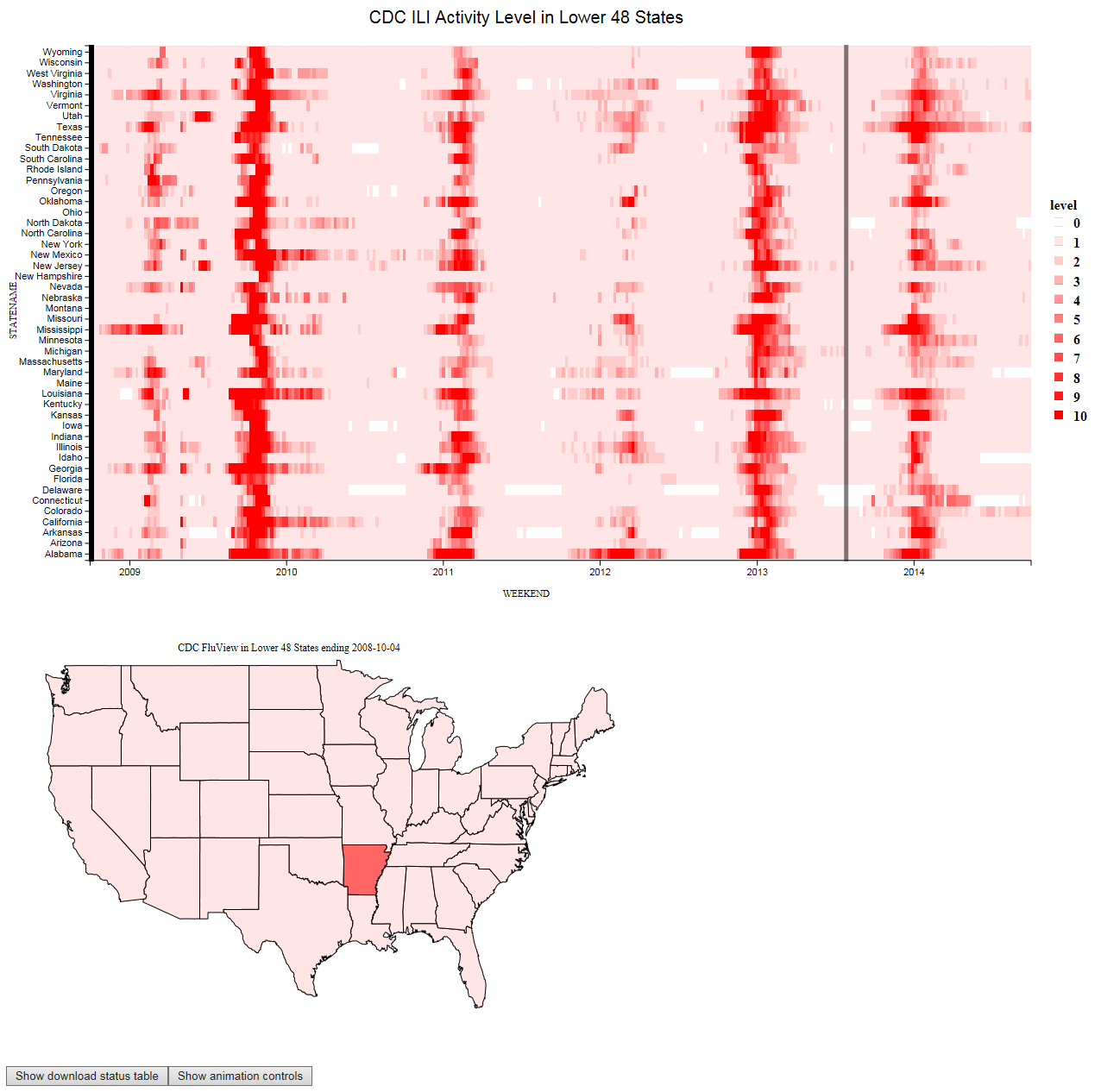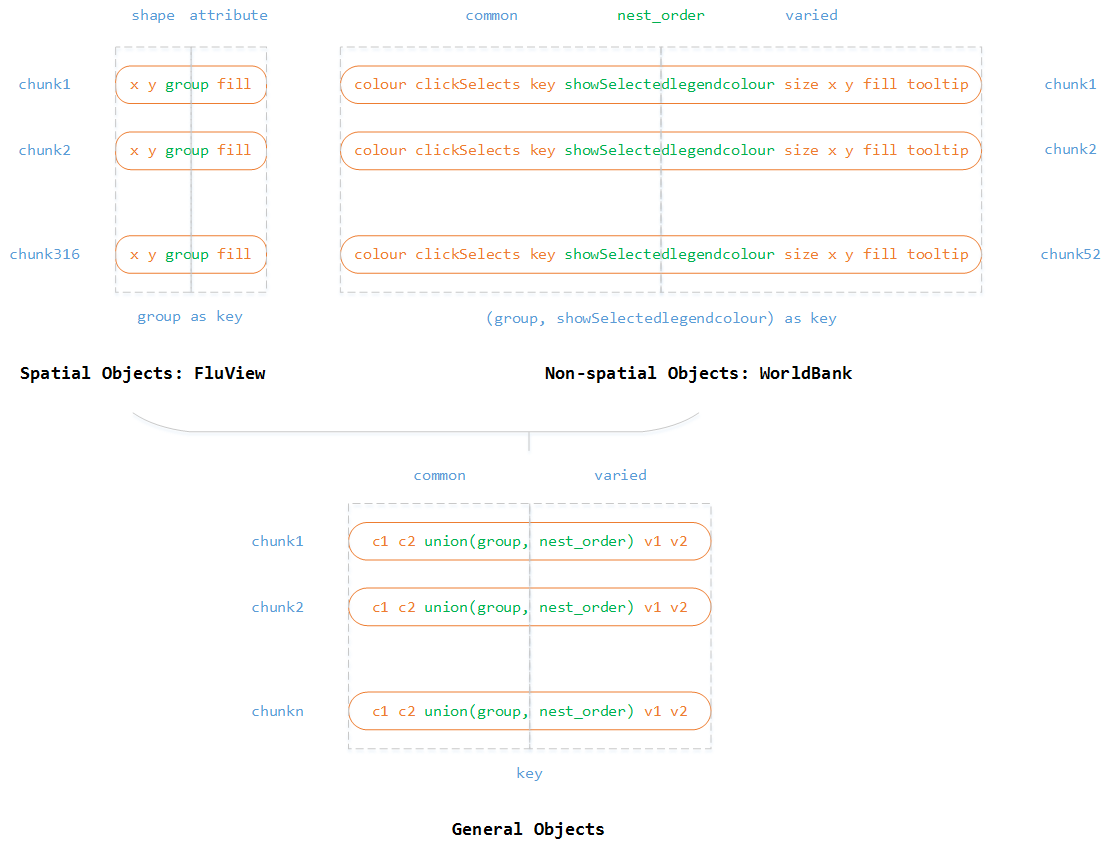Problem
The easy test for becoming a potential student of
animint project for GSoC 2015 is to use
animint to visualize some data from your domain of expertise, and upload your visualization to the web using animint2gist. I used animint to visualize the data from the
CDC’s State-level FluView, which is a main data source of my Ph.D.
influenza research. The script for generating the FluView viz can be found in
AnimintTest repository.
As shown in following figure, the FluView viz is comprised of two ggplots: the top is a heatmap, and the bottom is a map of US lower 48 states. In the top heatmap, WEEKEND is a selection variable. As the selected WEEKEND changes, the bottom state map is re-drawn to show the ILI activity levels across US lower 48 states at the selected WEEKEND, whose colors are mapping to the ILI activity levels.

However, there are some problems when using the current animint package to produce above FluView viz. First, after making the FluView viz, it took long time for animint2gist to upload the viz to
bl.ocks.org, but still failed.
> system.time(animint2gist(viz, out.dir = "FluView-old"))
Loading required namespace: gistr
Error in res$errors : object of type 'externalptr' is not subsettable
Timing stopped at: 148.793 16.205 412.56
So I had to upload the FluView viz to
my personal website to demonstrate it to
Toby Hocking, the creator of animint package. Second, when you play with the FluView viz, you will feel strongly that the interactivity experience of FluView viz is less responsive. After clicking on the top heatmap, it took long time for the viz to update the bottom map to show the ILI activity levels at selected WEEKEND.
Actually, these problems are caused by the large filesize of chunks generated by animint. Using the current animint package, the FluView viz took about 219 MB of chunks, which was too large for animint2gist to upload it. Individual chunk of geom4_polygon_stateMap for each WEEKEND had a filesize of 708 KB, which also took a while for the browser to load it and made the viz less responsive.
$ ls FluView-old/*.tsv|wc -l
316
$ du -hsc FluView-old/*.tsv|tail
708K FluView-old/geom4_polygon_stateMap_chunk91.tsv
708K FluView-old/geom4_polygon_stateMap_chunk92.tsv
708K FluView-old/geom4_polygon_stateMap_chunk93.tsv
708K FluView-old/geom4_polygon_stateMap_chunk94.tsv
708K FluView-old/geom4_polygon_stateMap_chunk95.tsv
708K FluView-old/geom4_polygon_stateMap_chunk96.tsv
708K FluView-old/geom4_polygon_stateMap_chunk97.tsv
708K FluView-old/geom4_polygon_stateMap_chunk98.tsv
708K FluView-old/geom4_polygon_stateMap_chunk99.tsv
219M total
Therefore, the disk usage of current animint package need to be optimized, at least for the FluView viz. As stated in the OPTIMIZATION category from the TODO list of features to implement in the README file of animint package, optimizations in terms of compiler/render speed, disk usage, memory, etc make animint easier to visualize large data sets, for example, the CDC FluView dataset. Hence, optimizations for animint become key project goals for my animint project proposal for GSoC-R 2015.
Solution
By inspecting the chunk files of FluView viz, we can see that each chunk of geom4_polygon_stateMap has saved the coordinates and fill colours of state polygons. Since using ggplot2 to draw maps, spatial objects are stored in data.frame, in which each row consists of coordinates of a vertex and attributes of the spatial object that the vertex belongs to (e.g. fill colours of state polygons in the FluView viz); however, in the FluView viz, the number of vertex (11527) to draw the borders of state polygons are far more than the number of state polygons (62 other than 48 because holes in some polygons), which leads to the repeated storage of attributes. By virtue of my background of GIS (Geographic Information System), I know the best spatial data storing approach is like
shapefile, one advantage of which is to separately store the shape and attribute in .shp file and .dbf table, avoiding the repeated storage of shape coordinates and simplying the storage of object attributes. So for spatial objects such as the FluView viz, I proposed the new chunk storing strategy as shown in the topleft panel of following figure.
By discussing with Toby Hocking, for non-spatial objects such as the frequent used WorldBank viz, there are also redundant information (common columns) across chunks. Hence, the common columns and varied columns should also be saved separately to chunk files. A new chunk storing strategy for non-spatial objects shown in topright panel of following figure is proposed.
 New chunk storing strategy
New chunk storing strategy
For generality, the optimization of disk uage for animint can be abstracted into the new chunk storing strategy shown in the bottom panel of above figure. The columns of each chunk are divided into three categories: common columns across chunks, varied columns across chunks, and key columns. The common and key columns are saved into an common chunk, which is an extra added chunk; the varied and key columns are saved to varied chunks, the number of which are the same. Key columns are saved to both common chunk and varied chunks to ensure that the renderer can recover the original chunk through joining common chunk to varied chunks by key columns. The key columns are expressed as union(group, nest_order), of which group is the column name that represents the row index before splitting the original chunk, and nest_order is a variable that is used for grouping rows in (both common and varied) chunks into a hierarchical tree structure in the renderer. It’s notable that group has already been included in the nest_order variable for some visualizations.
Therefore, the implements of the optimization for animint can be simplified into three main parts:
- Determining the common columns across chunks in the compiler
- Formalising the key columns in the compiler
- Recovering original chunks through joining common chunk into varied chunks by key columns in the renderer
To further reduce writing time and disk space, any rows with NA from varied chunks are not saved to tsv files. A benefit of deleting NA values in the compiler is to fix the warning of Unexpected value NaN parsing attributes from D3.js in the renderer.
Improvement
The pull request of optimizations to save disk space implements the new version of animint compiler and renderer based on the new chunk storing strategy.
For the above FluView viz, though an extra common chunk is generated by the new animint compiler, the viz takes only 4.4 MB, which is almost $1/50$ of the original filesize produced by the old animint compiler. Individual varied chunk of geom4_polygon_stateMap for each WEEKEND has a filesize of only 4 KB, which is almost $1/180$ of the original filesize. The sharp descrease in varied chunk filesize definitely reduces the loading time for the browser and makes the viz responsive.
$ ls FluView-new/*.tsv|wc -l
317
$ du -hsc FluView-new/*.tsv|tail
4.0K FluView-new/geom4_polygon_stateMap_chunk92.tsv
4.0K FluView-new/geom4_polygon_stateMap_chunk93.tsv
4.0K FluView-new/geom4_polygon_stateMap_chunk94.tsv
4.0K FluView-new/geom4_polygon_stateMap_chunk95.tsv
4.0K FluView-new/geom4_polygon_stateMap_chunk96.tsv
4.0K FluView-new/geom4_polygon_stateMap_chunk97.tsv
4.0K FluView-new/geom4_polygon_stateMap_chunk98.tsv
4.0K FluView-new/geom4_polygon_stateMap_chunk99.tsv
588K FluView-new/geom4_polygon_stateMap_chunk_common.tsv
4.4M total
The save chunk process of new animint compiler becomes more complex than the old one, but there are less chunk contents to write onto disk. As a result of trade-off, the compiling speed of the new animint compiler doesn’t increase dramatically comparing to the old one.
> system.time(animint2dir(viz, out.dir = "FluView-old"))
user system elapsed
115.830 12.223 128.720
> system.time(animint2dir(viz, out.dir = "FluView-new"))
user system elapsed
115.347 13.833 130.460
Now we can successfully post the FluView viz on gist by animint2gist, which takes almost the same amount of time with animint2dir. Playing with the
result, you can obviously feel that the interactivity experience has been improved. After clicking on the top heatmap, the bottom state map is updated in time that we can bear.
> system.time(animint2gist(viz, out.dir = "FluView-new"))
user system elapsed
98.872 17.935 134.384
For non-spatial objects, the new animint compiler can also reduce disk usage. For example the WorldBank viz, the disk space of chunk tsvs is reduced from 3.6 MB to 2.8 MB.
$ du -hsc WorldBank-old/*.tsv|tail
16K WorldBank-old/geom2_text_scatter_chunk52.tsv
8.0K WorldBank-old/geom2_text_scatter_chunk53.tsv
16K WorldBank-old/geom2_text_scatter_chunk6.tsv
16K WorldBank-old/geom2_text_scatter_chunk7.tsv
16K WorldBank-old/geom2_text_scatter_chunk8.tsv
16K WorldBank-old/geom2_text_scatter_chunk9.tsv
4.0K WorldBank-old/geom3_text_scatter_chunk1.tsv
4.0K WorldBank-old/geom4_tallrect_ts_chunk1.tsv
1.0M WorldBank-old/geom5_line_ts_chunk1.tsv
3.6M total
$ du -hsc WorldBank-new/*.tsv|tail
12K WorldBank-new/geom2_text_scatter_chunk52.tsv
12K WorldBank-new/geom2_text_scatter_chunk6.tsv
12K WorldBank-new/geom2_text_scatter_chunk7.tsv
12K WorldBank-new/geom2_text_scatter_chunk8.tsv
12K WorldBank-new/geom2_text_scatter_chunk9.tsv
8.0K WorldBank-new/geom2_text_scatter_chunk_common.tsv
4.0K WorldBank-new/geom3_text_scatter_chunk1.tsv
4.0K WorldBank-new/geom4_tallrect_ts_chunk1.tsv
948K WorldBank-new/geom5_line_ts_chunk1.tsv
2.8M total
Future Work
For small dataset like WorldBank viz, the animation works well for the new animint compiler and renderer; however, adding time = list(variable = "WEEKEND", ms = 3000), duration = list(WEEKEND = 1000) to the FluView viz, the new renderer still doesn’t provide smooth transitions between animation frames at different WEENEND with varied chunks small enough. This is because how the renderer draws state map hasn’t been optimized for the new chunk storing strategy. Actually, comparing to the old one, an extra step of joining common chunk into all varied chunks by key columns is added to the new renderer during chunk downloading process.
For each animation frame, the polygons of state map are constant and only the fill colours for polygons change. Hence, the best rendering approach is to separate geom drawing and attribute rendering. The renderer draws polygons of state map only at the initial rendering step using the common chunk, and for next animation frames only the fill colours for polygons are re-drawn only using corresponding varied chunks.